Top 1 percent in India were never so rich, shows new paper by Chancel and Piketty
Economic reforms, launched in 1991, have reduced poverty, claim all its supporters. But critics say the reforms have increased inequality, or the gap between the haves and the have-nots. That sounds paradoxical, but a new paper by Lucas Chancel and Thomas Piketty shows it is true.
The paper, titled
‘Indian income inequality, 1922-2014: From British Raj to Billionaire Raj?’ , is published by World Wealth and Income Database (‘WID.world’). Piketty, the French economist, revived the debate over inequality with his unlikely best-seller, ‘Capital in the Twenty-first Century’ (2013). Chancel is co-director of the World Inequality Lab and of the WID.world at the Paris School of Economics.
What the duo did was to “combine household surveys and national accounts, as well as recently released tax data in a systematic way to track the dynamics of Indian income inequality from 1922 to 2014”. What they found was: “According to our benchmark estimates, the share of national income accruing to the top 1% income earners is now at its highest level since the creation of the Indian Income tax in 1922.”
Among other findings:
- The top 1% of earners captured less than 21% of total income in the late 1930s, before dropping to 6% in the early 1980s and rising to 22% today.
- Over the 1951-1980 period, the bottom 50% group captured 28% of total growth and incomes of this group grew faster than the average, while the top 0.1% incomes decreased.
(In other words, we need to rethink the bad old days of so-called socialism and Garibi Hatao: inequality was indeed brought down, and the poor were empowered. The only thing wrong was the poor ‘Hindu rate of growth’. Economic reforms reversed both the trends.)
* Over the 1980-2014 period, the situation was reversed; the top 0.1% of earners captured a higher share of total growth than the bottom 50% (12% vs. 11%), while the top 1% received a higher share of total growth than the middle 40% (29% vs. 23%).
The authors conclude: “These findings suggest that much can be done to promote more inclusive growth in India.”
The key phrase, inclusive growth, is of course in currency for long, with both the Congress and BJP (“Sab ka Saath”) reiterating it. The data, however, shows that it remains elusive.
Governance Now devoted a cover story to the subject of inequality:

* * *
“The moral economy of the elite – and why they can't confront the inequality”
That was the title of the 2017 Durgabai Deshmukh Memorial Lecture, delivered by noted journalist P Sainath and organised by the Council for Social Development (CSD), on July 15 in New Delhi. Here’s what he said on this topic:
“Have a look at the Global Wealth Databook of 2016 brought out by Credit Suisse, the major multinational bank (they do not worry about poverty, they track wealth). If you look at the report, the top one percent of the Indian society now owns 58.4 percent of all households’ wealth. That is higher than any other country except Russia but we achieved it in a shorter duration.

“In year 2000, in the Credit Suisse report, the top one percent of Indians owned 36.8 percent of total household wealth. In 2014, top one percent owned 49 percent. In 24 months, the Indian top one percent added 9 percentage points of total household wealth to their ownership.
“Compare that with the US, the quintessential capitalist economy. The US, it is unanimously acknowledged, is more unequal than it has ever been, and the top one percent of Americans hold 42.1 percent of the total wealth of the US. You know what that means, by the way? Among other things, it means that the top one percent of Indians today hold the greatest share of wealth in their nation than the top one percent of the US ever did in the history of that nation. That’s how much inequality has grown.
“And even more tragically, in the last 12 months, when they added something like five percent to their wealth, the worth of the bottom decile or the bottom ten percent of the Indian society turned negative for the first time. It fell from 0.1 percent to –0.7 percent, suggesting that those whose liabilities were anyway ahead of their assets are sinking further into debt.
“Now look at the other bottom deciles. The second 10 percent of the Indian society holds 0.2 percent and the third section holds 0.5 percent. It means if you clubbed the bottom 30 percent together, they own zilch, virtually nothing.”
